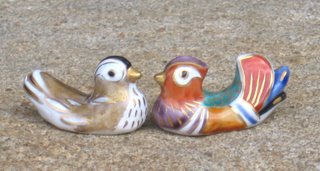:::::::::::::::::::::::::::::::::::::::::::::::::::::::::::::::::::::::::::::::::::::::::::::::::::::
- Illusions - Illusions - Illusions -
fish under water <>
the illusion of words
we think we know
Fische unter Wasser <>
die Illusion von Worten,
die wir glauben, zu kennen
鯱や 水に住まわず 夏来たる
(Translation from Onohi San)
Before you scroll down, close your eyes for a moment and imagine what kind of photo you would expect.
. fish . under . water .
each word taken at face value,
each word taken with a symbolic value,
what does it conjure up in your mind?
 |
These two fish are under a water fountain.
Now I will tell you a bit more about these fish-non-fish.
This is a scene from the Tile Museum in Kikuma Town, Ehime Prefecture, Shikoku Island.
These fish, or rather sea monsters or crocodiles are called Makara.
They decorate the roofs of Japanese castles and temples, in a prayer to protect the building of fires. The following link has a lot of information about this being. Sometimes the castle rooftiles are refered to as "Dolphins" too. Shachihoko 鯱(しゃちほこ)
The golden ones from Nagoya Castle are maybe the most famous. They are 2,58 m high and weigh 1215 kg!
shachi 鯱 "Dragon Fish"
棟飾り瓦の一つで魚の形をしている。頭は竜のようで、背上に鋭い刺を持つ想像的海魚で、海にすむことから防火の効き目があるという。しゃちとも言い、鴟尾が発展したものである。魚形の棟飾りは中国では宋時代にあらわれるが、日本では室町時代から登場している。インドのマカラの影響があったものと言われている。初期には仏閣で使われていたが、桃山時代からは城の天守閣や櫓で多用されるようになった。名古屋城の金の鯱が有名で、これは高さ258cm、重さ1215kg。使われている18金の重さは43.4kgとなっている。
http://www.khandro.net/mysterious_makaras1.htm
Safekeep copy
http://groups.yahoo.com/group/DarumaArchives-002/message/62
My Story about the Gods of the Elements.
http://darumapilgrim.blogspot.com/2005/02/suijin-god-of-water.html
:::::::::::::::::::::::::::::::::::::::::::::::::::::::::::::::::::::::::::::
Kikuma Tile Museum
Ceramics of a different nature can be found at the seaside town of Kikuma, which has been engaged in traditional roof tile production for several hundreds of years. Kikuma-gawara, as the local tile is known, is of such a high grade, it is even made by appointment to the Imperial Household in Tokyo.
Visitors to the Kawara-no-Furusato Park can try their hand at making tiles to take home. In fall, the town fills with excitement when it comes time for the annual festival. The 500-year-old festival reaches its peak when young boys astride splendidly decorated horses gallop up the approach to the Kikuma Shrine
http://www.jnto.go.jp/eng/RTP/Setouchi/outline.html
Here is a link to the Tile Museum of Kikuma Town.
http://home.e-catv.ne.jp/tour-ehime/kikuma.htm
:::::::::::::::::::::::::::::::::::::::::::::::::::::::::::::::::::::::::::::::::::::::::::

鯱乗り童子 Child sitting on a Shachi
about 23 cm high
. Asahi tsuchi ningyoo 旭土人形 Asahi Clay Dolls .
Aichi

about 13 cm high
:::::::::::::::::::::::::::::::::::::::::::::::::::::::::::::::::::::::::::::::::::::::::::
 summer sea - even the sunshine sparkles under water |
::::::::::::::::::::::::::::::::::::::::::::::::::::::::::::::::::::::
well done gabi.
great piece and i certainly wasnt expecting that.
this is what i saw, sort of.
thanks, Ashe
And thanks to you, Ashe san !
Gabi
:::::::::::::::::::::::::::::::::::::::::::::::::::::::::::::::::::::::::::::::::::::::::::::::::::::
[ . BACK to WORLDKIGO TOP . ]
[ . BACK to DARUMA MUSEUM TOP . ]
:::::::::::::::::::::::::::::::::::::::::::::::::::::::::::::::::::::::::::::::::::::::::::::::::::::








10 comments:
Hello GokuRakuAn
Got me totally by surprise! Thoroughly enjoyed the haiku & the photo!
G.
Dear Gabiさん:
Did you have a good time in Ehime?
I hope so.
You always impress me with your diligence!
Good studies and beautiful photos!
Oh! Wonderful haikus, of course!
I very thank you for your love and understanding
to Japanese cultures, nature, and to people.
I tried to make a haiku on your fine photo.
I know few English words, so it may not be well.
Summer has come!
Residing out of water,
Shachihokos in pairs-
鯱や 水に住まわず 夏来たる
( shachihoko-ya mizu ni sumawazu natukitaru )
I hope you send many virtues of Japan
to the whole world, ever and ever.
Sincerely,
をのひ (Onohi) from BLOG句会 (^-^)
Dear Onohi San !
Thank you so much for your Japanese haiku!
I will try hard to continue bringing Japan to my Haiku Friends!
Kongo tomo Yoroshiku Onegai Shimasu!
Gabi
I also did not see your photo at first, Gabi, and only when I saw ashe's image did the meaning of the haiku hit me.
I cannot recall seeing a combination where the photo is so necesary for the completion of the haiku.
A great combination
Thanks very much, both of you.
J.
Dear Gabi,
the fishes
in the trout hatchery
dazzling light
silvery
in the pond
the carps
a lightning flash
through the water
the spawn
GEERT
............
Thank you, Geert!
Gabi
Gabi, I just love your fishy page, lol!
And Ashe, your image is so cool...
:~)
L.
Here is one with a similar touch !
http://alberni.net/~jswift/photo-haiku/slides/asitseems.htm
Thank you!
Nagoya Castle 名古屋城 ............................
Ise no Shiro 伊勢の四郎
Once Ise no Shiro 伊勢の四郎 captured some robbers in a deep mountain forest, but he saved the daughter of one in exchange for a pair of golden shachihoko 鯱.
They are still to be seen on the roof of Nagoya castle.
They were crafted not only to show off the power of Tokugawa Ieyasu, but also took a role of war funds in an emergency.
... However in 1726, 1827, and 1846, when the domain of Owari experiencing financial difficulties, the Owari government removed the shachihoko scales and recasted them.
In addition, the government covered the shachihokos with wire netting
in order to protect them from big water birds named 'kou' in Japanese (these wire nets made for a funny story later).
A legend said that the 'kou' brings a dead twig aflame. The 'kou' once made a nest and put the fin to good use.
- More photos and stories :
- source : kikuko-nagoya.com -
.
MY BLOG
http://heianperiodjapan.blogspot.jp/2015/08/shiro-castle-legends.html
.
tenshukaku 天守閣 castle tower, castle keep
with shachihoko decoration
.
https://edoflourishing.blogspot.com/2019/06/tenshukaku-edo-castle-tower.html
.
- quote -
it was Oda Nobunagana whose Azuchi Castle (安土城) in the 1570s was considerd the first to show a"shachihoko 鯱," indicating that the role of the castle has shifted to more of "show" of power from the strategic mountain castles where no such shachihoko 鯱 decorations are found.
Since Nobunagawa was fond of Chinese ideas, the concept of "shachihoko 鯱" seems to lead back to the Chinese practice of placing dragon heads on the palace roofs but without the dragon body.
.
Yoshio
.
Post a Comment